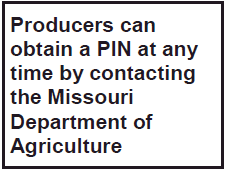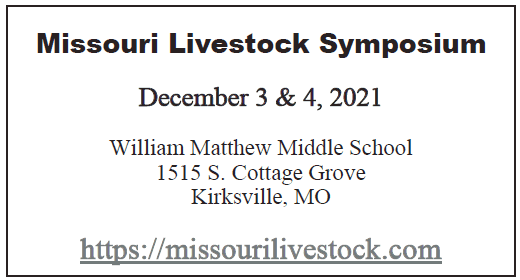

To send a message to an author, click on the author's name at the end of the article.
This Month in Ag Connection | Ag Connection - Other Issues Online
Native warm season grasses (NWSG) can be a good addition to a grazing system. They are most productive in the summer when temperatures are between 85- and 95-degrees Fahrenheit. Big bluestem, indiangrass, switchgrass and eastern gamagrass are a few of the NWSG found in northern and central Missouri. Many of these grew on the prairies before settlers arrived and began to cultivate the soil.
Deep root systems make NWSG drought tolerant. This coupled with the fact they grow best when temperatures are warm, mean they are very productive during late June, July and August. They complement cool season grasses (CSG) like tall fescue, smooth bromegrass, orchardgrass, and timothy, in a grazing system, providing forage during the time CSG are less productive.
Selecting a suitable site for NWSG establishment is the first step. Cool and warm season grasses can be grown in the same field, but care must be taken not to give one a competitive advantage over the other. Timing of fertilizer applications, timing of hay harvest or grazing, and harvest or grazing height all differ for cool season and warm season species. Managing the two types of grasses in separate fields is less complicated.
Adequate fertility and soil pH increase the success rate of establishment. Apply phosphorus, potassium, and lime to bring the soil up to the recommended soil test levels. Keep nitrogen fertilizer applications to a minimum the first year to reduce weed competition.
Weed control is critical for successful NWSG establishment. When planting into a CSG sod, two or three burndown herbicide applications may be needed to eliminate the existing vegetation, and planting a smother crop can help suppress the original sod.
Once the field has been planted, weed control is essential for rapid establishment. Herbicides labeled for NWSG or mowing weedy stands at a height of six inches to reduce completion, may be necessary. Read and follow all label directions when applying pesticides.
Native warm season grasses can be seeded in the winter or spring. Dormant seedings are made in winter months when the soil temperature is below 55 degrees. Seed will not germinate until the soil warms to 65 degrees in the spring. Because NWSG tend have a high percentage of dormant seed, this method of seeding can increase the percentage of seed which germinate when the soil warms. Spring seedings can be made when the soil reaches 65 degrees.
Refer to MU Extension Guide 4673: Big Bluestem, Indiangrass and Switchgrass, https://extension.missouri.edu/publications/g4673, or contact a member of the NRCS+MU Grasslands Project https://extension.missouri.edu/programs/nrcs-mu-grasslands-project team member for more information about planting NWSG.
Source: Valerie Tate, Agronomy Specialist
This Month in Ag Connection | Ag Connection - Other Issues Online
While African Swine Fever (ASF) is not a human food safety issue, it has potential to cause great economic detriment to American pork producers. Producers need to be aware of the recent occurrence.
An outbreak of ASF has been reported in the Western Hemisphere for the first time in 40 years. The outbreak was reported in the Dominican Republic in July and spread to Haiti in September. The United States is working to help ensure the outbreak does not spread to other countries or US territories.
African Swine Fever is a highly contagious viral disease, specific to swine which causes severe bleeding and quick death. There is no treatment or vaccine available. The only way to stop the disease is to depopulate infected herds.

To combat contagious diseases such as ASF and Classical Swine Fever, the United States has developed the Secure Pork Supply plan. The plan provides a way for farms that are not infected, to continue business. If ASF is found in the US, Regulatory Officials will halt the movement of animals and animal products for several days. A control area will be established around farms with infected animals. No new animals will enter the control area until the disease is contained. Movement within or out of the control area will cease until specific conditions are met.
Producers can prepare for a disease outbreak in advance so business within a control area can resume more quickly. All farms will need a premise identification number (PIN). Stringent biosecurity practices will be put in place and movement records for animal traceability will be required before animal movement can resume. A veterinarian or Extension specialist can help plan biosecurity measures. Visit securepork.org to view the Secure Pork Plan or learn more.
https://www.aphis.usda.gov/publications/animal_health/asf.pdf
https://agriculture.mo.gov/animals/health/animalid.php
Source: Jenna Monnig, Livestock Specialist
This Month in Ag Connection | Ag Connection - Other Issues Online
Income tax time is not a favorite time of year for most farmers, but it is critical to be prepared. University of Missouri Extension provides several resources to assist you.

This year has brought several specific COVID-related programs that have income tax implications. University of Missouri Extension will hold a Farm Tax Workshop on Wednesday, December 1. The program will be repeated on Thursday, December 2. The program runs from 6:15 to 8:30 pm and held online or in-person at the following locations:
December 1
Registration information is available online at https://tinyurl.com/taxwkshp21
Topics will include COVID-related programs, Qualified Business Income Deduction (QBI), business entity taxation issues, energy (wind, carbon, etc.) payments, individual taxpayer issues, and depreciation of farm assets. Any newly passed legislation will also be discussed. Contact the county extension office to register for these sites or online. Important reasons to attend (1) cash-basis taxpayers can manage potential tax liability before the end of the year and (2) individuals are responsible for knowing the laws and impacts even when taxes are prepared by a professional.
An income tax estimate is a valuable tool this time of year. By calculating annual income, annual expenses and depreciation before the end of the year, farmers can evaluate tax status while there is still time to make adjustments.
Publication 225 (Farmer's Tax Guide), a reference booklet for farm taxes will be available at each county extension office. Some offices may have additional income tax forms, such as the 1099 and 1096 forms. Remember, 1099 NEC forms are utilized for most farm custom or contractor work (combining, haying, dozing, etc.), while the 1099 MISC form is for cash rent, attorney or veterinary labor, etc. These forms must be sent to the recipient and to the IRS by February 1, 2022.
Source: Joe Koenen, Ag Business Specialist
This Month in Ag Connection | Ag Connection - Other Issues Online
People drive by Sanborn Field east of the MU campus and don't give it a second look. At best, it looks like an empty lot - something where a new residence hall could be built someday.
It's proven to be much too valuable for that. For almost a century and a quarter, the farm plots at Sanborn have yielded significant scientific information about the health and best use of Missouri soils, soil erosion, fertilizer run-off, crop rotation, and best methods to recover exhausted soils.
For all of this, however, Sanborn is most famous for its role in the creation of Aureomycin, a contemporary of penicillin.
Shortly following World War II, new "miracle drugs" revolutionized the medical treatment of infections. These new drugs included several types of substances found to have antibacterial and antiviral properties. One of these classes of drugs was tetracyclines - a family of antibiotics similar to penicillin, but more effective against a wide range of infections.
In 1945, Benjamin Duggar, son of a country doctor and a pathologist-physiologist at Lederle Laboratories in New York, was searching for organisms producing tetracycline antibodies. He asked Mizzou soil scientist William Albrecht for promising Missouri soil samples. Albrecht suspected that Plot 23 at Sanborn could contain fungal samples of use to Duggar.
Duggar found its soil contained a golden mold that suppressed the growth of many microorganisms, including streptococci.
124 Years of Continuous Soil Research
Sanborn Field was established in 1888 by J.W. Sanborn, director of the Missouri Experiment Station and dean of the MU College of Agriculture, to demonstrate crop rotation and the production of winter wheat. Later, corn, soybeans and sorghum were added to his research projects list. Most research studied soil changes, crop responses to fertilizer and tillage, and the effects of differing nutrient balances - all good clues in understanding the health of Missouri soils.
Sanborn is the oldest continuous experimental field west of the Mississippi River. Of its 45 plots, one is still in the native prairie species common to Missouri before the influx of European settlers - a perfect control sample. Nine plots are still involved in the original cropping program started by Sanborn, yielding 124 years of data of plant growth, human intervention and soil quality.
This old research is valuable because of the records that have been kept for each experiment, be it the application of animal manure or the planting of clover, said Randy Miles, Sanborn Field director. Each intervention's effects have been scientifically measured, and each crop harvest carefully recorded along with accompanying weather observations. For soil scientists like Miles, having such cause-and-effect data for almost a century and a quarter is of immeasurable help. There are almost no farm lands in Missouri, or in the established ag world, where such continuous long-term recorded research results exist, Miles said.
This means that Sanborn's soil is a unique time capsule that is little changed. No herbicide has ever been used on some plots. Most crops were harvested by hand or with modified small tractors, minimizing mechanical change to the ground.
The Sanborn scientists also have "snapshots" of the soil at different points in the last century. MU researchers captured and saved deep core samples in 1915, 1938, 1962 and 1988. These samples have great research value as they show how much carbon was captured and retained both at the surface and below tillage level, Miles commented. Carbon nearer the surface trends to fluctuate dramatically with farm use while deeper portions reflect longer term trends.
These core samples have showed that most agricultural soils may have already lost 30 to 75 percent of their antecedent soil organic carbon pool, Miles said. The implications of additional carbon loss to future generations could be enormous, he continued.
Aureomycin Is Developed to Complement Penicillin
In 1948, Duggar labeled the Sanborn fungus as A-377, which was later named Streptomyces aureofaciens. Plot 23 became the source of this fungus, and a soil sample from Plot 23 was made a part of the scientific collection at the Smithsonian Institution.
The antibiotic developed from Streptomyces aureofaciens was named Aureomycin. Aureomycin was effective against 90 percent of bacteria-caused infections. In human trials, it was found to have minimal side effects, too. Unlike penicillin and streptomycin, which had to be injected, Aureomycin could be taken orally. Aureomycin was also effective in treating diseases that did not respond to other antibiotics, such as trachoma, parrot fever, typhus, chlamydias and mycoplasmas. It was also effective against Rocky Mountain spotted fever, an infection which had spread throughout the United States. Caused by a microorganism called rickettsia and transmitted by a tick, the disease was fatal in one out of every five patients.
Aureomycin was used well into the 1980s. Many medical experts considered it to be the least toxic and most effective antibiotic next to penicillin. However, because tetracyclines were used so widely against a variety of diseases, several strains of bacteria have developed resistance to them. As a result, physicians today seldom prescribe Aureomycin to people.
But its contribution has not been forgotten. Written on the monument over Duggar's grave in Alabama is the statement that Aureomycin saved millions of lives.
Source: Randy Mertens, MU CAFNR
Trivia: In 1965, Sanborn Field was added to the National Register of Historic Places. The event was attended by a KOMU news crew who recorded the event on 16 mm black and white movie film.
This Month in Ag Connection | Ag Connection - Other Issues Online

Publishing Information
Ag Connection is published monthly for Northeast and Central areas of Missouri producers and is supported by the University of Missouri Extension, the Missouri Agricultural Experiment Station, and the MU College of Agriculture, Food and Natural Resources. Managing Editor: Mary Sobba.